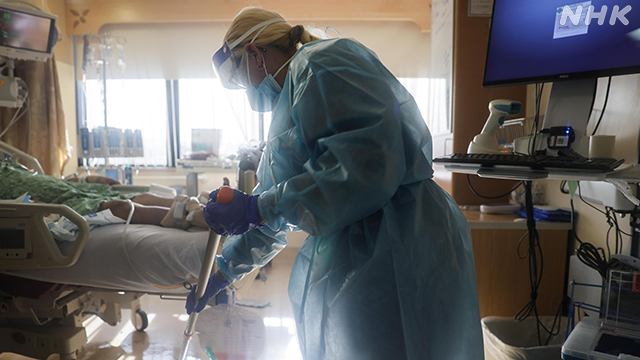The government's "Coronavirus Infection Control Subcommittee" has "the degree of medical tightness," "the number of people receiving medical treatment," and "the positive rate of PCR tests" as indicators for determining which of the four stages that indicate the infection status. "The number of newly infected people" and "The ratio of people whose infection route is unknown" are shown.
Of these, there are three items for "medical pressure": "bed usage rate," "hospitalization rate," and "bed usage rate for the severely ill."
According to the summary of the Cabinet Secretariat, the
10 prefectures that have declared a state
of
emergency and the prefectures to which
"priority measures such as spread prevention" are applied are the
most in Osaka and Okinawa prefectures as of the 15th. There are several items that correspond to the serious "Stage 4".
Some local governments publish different values for bed-related indicators based on the number of beds that can be immediately accepted.
1-1. Medical tight usage rate
First is the tightness of medical care.
As a guide, the bed usage rate is 20% or more for stage 3 and 50% or more for stage 4.
The usage rate of the entire sickbed is 48% in Hokkaido, 22% in Tokyo, 24% in Saitama, 26% in Chiba, 28% in Kanagawa, 48% in Aichi, 23% in Mie, and Gifu. 27%, Osaka prefecture 30%, Hyogo prefecture 29%, Kyoto prefecture 36%, Okayama prefecture 21%, Hiroshima prefecture 30%, Fukuoka prefecture 37%, Okinawa prefecture 87%.
1-2. Medical pressure hospitalization rate
The standard hospitalization rate is 40% or less for stage 3 and 25% or less for stage 4.
The hospitalization rate is 29% in Hokkaido, 42% in Tokyo, 39% in Saitama prefecture, not applicable to Chiba prefecture, not applicable to Kanagawa prefecture, not applicable to Aichi prefecture, not applicable to Mie prefecture, 74% in Gifu prefecture, 20% in Osaka prefecture, 57% in Hyogo prefecture, 42% in Kyoto prefecture, not applicable in Okayama prefecture, 53% in Hiroshima prefecture, not applicable in Fukuoka prefecture, 31% in Okinawa prefecture.
See the end of the sentence for "Not applicable".
1-3. Medical pressure severely ill
As a guide, the bed usage rate for severely ill people is 20% or more in stage 3 and 50% or more in stage 4.
The bed usage rate for the severely ill is 22% in Hokkaido, 33% in Tokyo, 18% in Saitama, 21% in Chiba, 22% in Kanagawa, 47% in Aichi, 18% in Mie, Gifu. It was 20% in prefecture, 25% in Osaka prefecture, 42% in Hyogo prefecture, 24% in Kyoto prefecture, 7% in Okayama prefecture, 29% in Hiroshima prefecture, 25% in Fukuoka prefecture, and 77% in Okinawa prefecture.
2. Number of recuperators
Next, the number of people receiving medical treatment should be 20 or more in stage 3 and 30 or more in stage 4 per 100,000 population.
63 in Hokkaido, 24 in Tokyo, 14 in Saitama, 14 in Chiba, 18 in Kanagawa, 32 in Aichi, * 10 in Mie, 15 in Gifu, Osaka There were 46 people in Hyogo prefecture, 16 people in Kyoto prefecture, 7 people in Okayama prefecture, 14 people in Hiroshima prefecture, * 30 people in Fukuoka prefecture, and 136 people in Okinawa prefecture.
* "10 people" in Mie prefecture is rounded off "9.7 people"
* "30 people" in Fukuoka prefecture is rounded off "29.9 people"
3. Test positive rate
This is the positive rate of PCR tests for the last week.
As a guide, stage 3 is 5% or more, and stage 4 is 10% or more.
3.7% in Hokkaido, 4.0% in Tokyo, 2.5% in Saitama, 4.7% in Chiba, 5.9% in Kanagawa, 5.8% in Aichi, 2.8% in Mie, 2.6% in Gifu, 2.6% in Osaka It is 1.0%, 2.6% in Hyogo prefecture, 3.0% in Kyoto prefecture, 1.3% in Okayama prefecture, 2.0% in Hiroshima prefecture, 1.6% in Fukuoka prefecture, and 7.0% in Okinawa prefecture.
4. Number of newly infected people
As a guide, the number of newly infected people in the last week per 100,000 population is 15 or more in stage 3 and 25 or more in stage 4.
17 in Hokkaido, 19 in Tokyo, 8 in Saitama, 11 in Chiba, 14 in Kanagawa, 12 in Aichi, 5 in Mie, 7 in Gifu, 7 in Osaka. There are 9 people in Hyogo prefecture, 8 people in Kyoto prefecture, 3 people in Okayama prefecture, 7 people in Hiroshima prefecture, 6 people in Fukuoka prefecture, and 62 people in Okinawa prefecture.
5. Percentage of people with unknown infection route
Finally, the percentage of people whose infection route is unknown.
The standard value is 50% for both stage 3 and stage 4.
37% in Hokkaido, 64% in Tokyo, 50% in Saitama, 56% in Chiba, 57% in Kanagawa, 47% in Aichi, 31% in Mie, 41% in Gifu, 41% in Osaka. It was 63% in Hyogo prefecture, 47% in Kyoto prefecture, 33% in Okayama prefecture, 32% in Hiroshima prefecture, 53% in Fukuoka prefecture, and 48% in Okinawa prefecture.
The newly adopted "hospitalization rate" as an index is the ratio of those who have been hospitalized to all the recuperators.
As the number of patients with the new coronavirus increases, the number of patients who should be hospitalized but cannot be hospitalized and receive medical treatment at home or institution increases. Therefore, the lower the "hospitalization rate", the more patients cannot be accepted. In other words, medical care may be tight.
However, the government's "New Coronavirus Infectious Disease Control Subcommittee" does not apply in the following cases.
When the number of medical treatment is less than 10 per 100,000 population.
This is the case when the number of new positives who need to be hospitalized can be hospitalized by the day after the notification of the outbreak.
No stage judgment is made for these municipalities.

